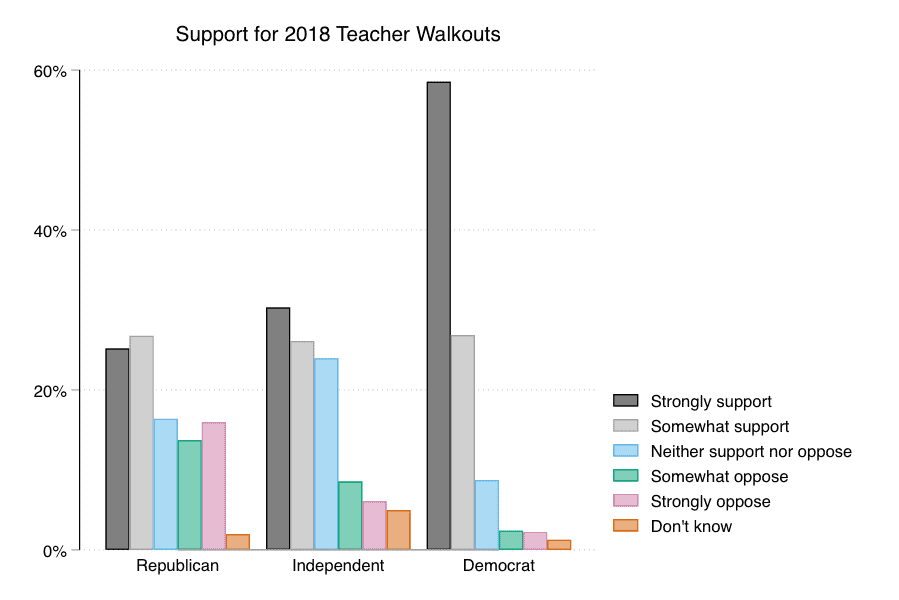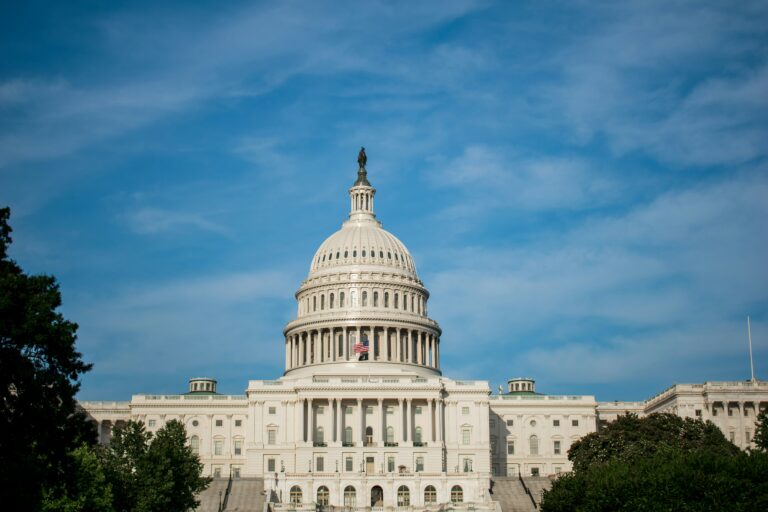
Alexander Hertel-Fernandez is an assistant professor of public affairs at Columbia University and a visiting scholar at the Russell Sage Foundation.
Nearly a year ago today, West Virginian public school teachers announced a statewide strike, launching a wave of unprecedented labor action among U.S. educators. The strike wave continued through public schools in a number of deep-red states, including Oklahoma, Kentucky and Arizona, as well as purple North Carolina and Colorado. Building on the momentum from 2018, Los Angeles teachers struck against their school district in early 2019 and were promptly followed by educators in Denver. What is remarkable is not only that the strikes happened—especially in quite conservative states—but that the strikes succeeded in raising teachers’ pay and benefits and boosting education spending and resources for students.
In ongoing work with my Columbia University colleagues Suresh Naidu and Adam Reich, I am exploring how the public thought about the strikes and whether the strikes changed how the public—and especially parents—think about unions and the labor movement. Initial results from a survey of the six 2018 walkout states reveals strong support for the teachers, their unions, and even for future labor action by teachers.
First, some background on our ongoing study. To understand how Americans thought about the strikes, we fielded an original online survey in January 2019 of 4,468 adults living in the six states in which teachers staged widespread walkouts in 2018. Although our survey was not a probability sample of these states (as with conventional random digit dialing polls), we designed the sample to match the demographics of the six states, including matching respondents based on education, race and ethnicity, gender, and parents versus non-parents. As a result, our survey respondents looked very similar to the overall make-up of the six states on these and other demographic characteristics, as well as in terms of their partisanship and political engagement.
Our survey asked respondents about what they remembered from the strikes, how they learned about the strikes, what effects they thought the strikes had on students, teachers, and their community, and their attitudes towards teachers and the labor movement in general. It therefore offers a unique perspective into the attitudes and perceptions of Americans most directly affected by the walkouts and represents the most detailed survey of the walkouts to date.
In all, about 80% of respondents indicated that they remembered the walkouts, though this ranged from over nine in ten respondents from Arizona and Oklahoma to around seven out of ten in Kentucky and North Carolina. Among those respondents who remembered the walkouts, the most common way that they reported learning about the strikes was from local television coverage (64% of respondents said that they heard from this source), followed by national television (51%), social media (44%; the most common source was Facebook), friends, family members, or coworkers (33%), and local newspaper coverage (27%). About 23% of respondents who recalled the walkouts said that they learned about the efforts directly from the teachers and unions themselves. But there were big differences in how respondents learned about the strikes by state. Respondents in Oklahoma and West Virginia were especially likely to learn about the strikes through social networks—like friends, family members, co-workers, and churches. By comparison, social networks were not a common way respondents in Colorado or North Carolina learned about the strikes.
We saw a similar story when we asked respondents whether they had firsthand experience with strikes in their local communities or their children’s schools. Overall, slightly less than half of respondents said that they had firsthand experience with the strikes in their local communities, but this ranged from about eight out of ten respondents in West Virginia and Oklahoma to less than a third in Colorado and North Carolina.
We also asked respondents what they thought teachers were demanding in the walkouts. By far, respondents identified higher wages and salaries as the main demand of teachers (83% of respondents said so) but about half of respondents also pointed to demands for higher spending on education and better classroom resources and supports. The survey further suggests that the public was attuned to the state-specific demands that teachers were making – for instance, our respondents recognized the emphasis on retirement benefits for teachers in Kentucky and on health insurance for West Virginian teachers.
What was overall support for the walkouts? By far, most respondents indicated that they either strongly or somewhat supported the walkouts. 39% of respondents said that they strongly supported the walkouts, and another 27% said that they somewhat supported the walkouts. Only 15% of respondents said that they somewhat or strongly opposed the walkouts. Across the states, strong support tended to be highest in Oklahoma and Kentucky, and lowest in Colorado. Notably, support for the walkouts stretched across partisan lines. Although liberals and Democrats were substantially more likely to indicate that they personally supported the walkouts, about half of Republicans and conservatives still said that they personally supported the walkouts, as I show in the figure below.

Support for the walkouts was also higher among individuals who learned about the walkouts from teachers or unions directly or through social media rather than other sources (especially talk radio). And support for the walkouts was higher among individuals who perceived teachers as demanding higher spending on education or better classroom resources as opposed to thinking that the strikes were only about teacher pay or benefits.
Lastly, we probed whether respondents would support future strikes by teachers in their local communities over pay, benefits, and spending on schools. On the whole, respondents were very willing to support future strikes, with over 60% of respondents supporting each of the three hypothetical strikes we described. Respondents voiced the strongest support for further strikes over school spending, with 40% of respondents saying that they would strongly support such strikes and another 28% of respondents saying that they would somewhat support them. Support was even higher among respondents who recalled the first round of walkouts.
What can we learn from these early results? First and foremost, they suggest that the public has teachers’ backs: even a year after the first round of strikes began, Americans in walkout states indicated that they still strongly supported the strikes. Second, the differences across states, especially Oklahoma and West Virginia compared to Colorado and North Carolina, suggest the need to consider how the strikes unfolded on the ground and the implications of those differences for public support. The results I have presented here suggest that the teachers in Oklahoma were especially effective in reaching across their state through social networks, and more research is needed to understand how that was accomplished. My colleagues and I will be looking into these questions in the coming months. And finally, our item about future strikes shows that far from turning the public (including parents) against strikes and labor action, there is still very broad support for future labor mobilization. It is now up to unions to take advantage of this public support.








Daily News & Commentary
Start your day with our roundup of the latest labor developments. See all
April 24
Workers in Montreal organize the first Amazon warehouse union in Canada and Fordham Graduate Student Workers reach a tentative agreement with the university.
April 23
Supreme Court hears cases about 10(j) injunctions and forced arbitration; workers increasingly strike before earning first union contract
April 22
DOL and EEOC beat the buzzer; Striking journalists get big NLRB news
April 21
Historic unionization at Volkswagen's Chattanooga plant; DOL cracks down on child labor; NY passes tax credit for journalists' salaries.
April 19
Alabama and Louisiana advance anti-worker legislation; Mercedes workers in Alabama set election date; VW Chattanooga election concludes today.
April 18
Disneyland performers file petition for unionization and union elections begin at Volkswagen plant in Tennessee.